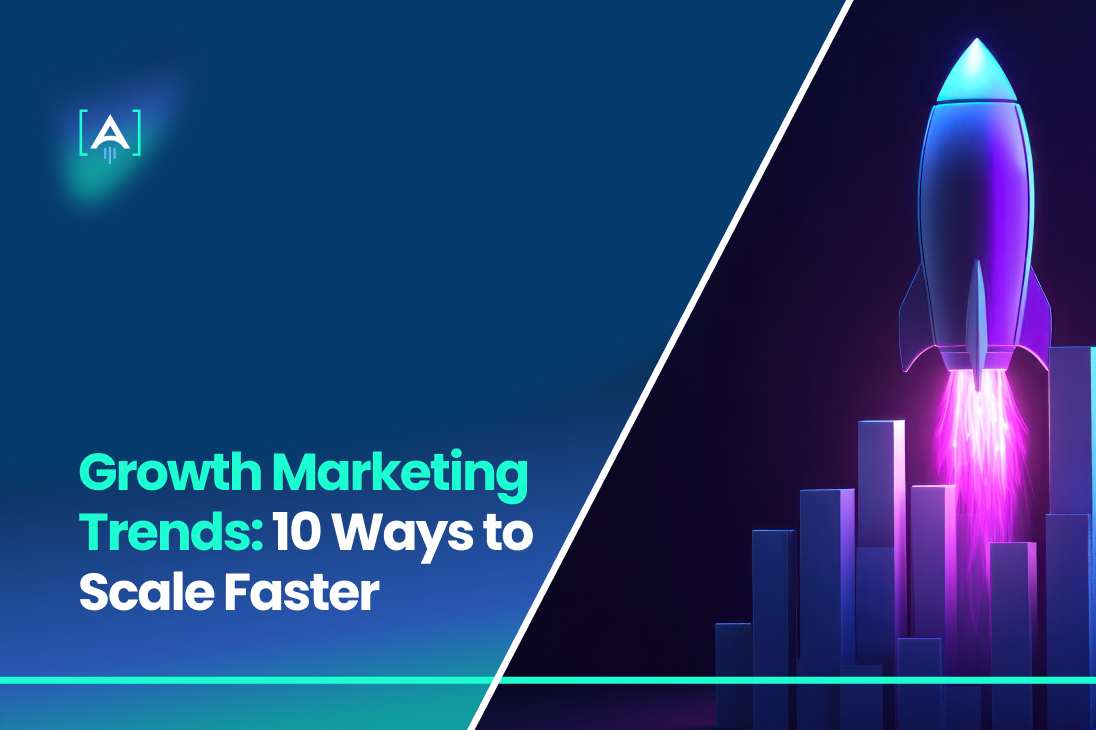Scaling your business has great potential if you use the right strategies.
Growth marketing has emerged as the key to driving faster, more sustainable expansion by focusing on smarter, data-driven tactics that impact every stage of the customer journey.
Whether it’s leveraging AI in marketing for personalized experiences or finding new ways to optimize your marketing conversion funnel, businesses today have more tools than ever to scale efficiently.
In this article, we’ll explore 10 growth marketing trends that are transforming the way companies accelerate their growth.
These strategies are designed to help you attract more customers, increase retention, improve ROI, and build lasting relationships that fuel long-term success.
Let’s explore how you can use these trends to scale faster and smarter in the future.
1. Full-cycle personalization with AI
Personalization is no longer just a “nice-to-have” feature—it’s become one of the most vivid growth marketing trends in driving growth.
In 2021, the global revenue for customer experience personalization and optimization tools was $7.6 billion, and it’s expected to grow to $11.6 billion by 2026—a 65% increase in just five years.
However, to truly scale, personalization must go beyond one-off email campaigns or product recommendations.

Source: Slideshare
With AI, businesses can create a fully personalized experience across the entire customer journey, from when a potential customer discovers your brand to the point where they become loyal advocates.
Take Netflix, for example. It uses AI-driven algorithms to recommend shows and movies based on your viewing history, preferences, and even what similar users are watching.
This keeps users engaged and returning, which is why Netflix’s retention strategy works wonders in reducing customer churn.
You can apply this same principle to your marketing by using AI-powered tools to tailor content, hook models, offers, and experiences to each customer.
Start by implementing AI-driven CRM systems that gather data from multiple touchpoints—social media, email, website visits—and use it to create dynamic, personalized marketing across all platforms.
This boosts engagement and improves conversion rates by making each interaction feel relevant and timely. The result? Happier customers and faster growth.
Key Metric to Track: Measure the impact of personalization by tracking customer engagement, conversion rates, and retention metrics across different customer segments.
2. Data-Driven Multi-Channel Marketing
To scale faster, businesses must move beyond relying on a single marketing channel. Consumers interact with brands across various platforms—social media, email, websites, and even in-store experiences. Multi-channel marketing, when driven by data, ensures you reach your audience wherever they are with the right message at the right time.
Take Sephora, for example. They seamlessly integrate online and in-store experiences by tracking customer preferences through their app, website, and physical stores.
Customers who browse a product online might receive a personalized email reminder or see a targeted social media ad for that exact product. This consistency across touchpoints makes the shopping experience feel cohesive and personalized, increasing the likelihood of purchase.
Sephora’s Data-Driven Multi-Channel Strategy:
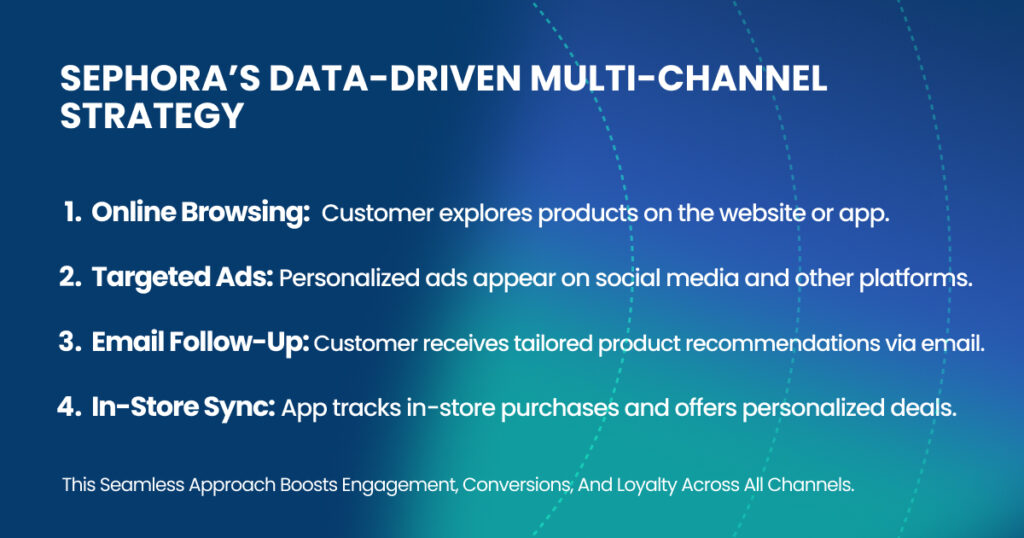
- Online Browsing: The customer explores products on the website or app.
- Targeted Ads: Personalized ads appear on social media and other platforms.
- Email Follow-Up: Customer receives tailored product recommendations via email.
- In-Store Sync: The app tracks in-store purchases and offers personalized deals.
This seamless approach boosts engagement, conversions, and loyalty across all channels.
To do this effectively, use data analytics tools to track how customers move across different platforms.
Identify key touchpoints in their journey, then create a unified strategy that ensures consistent messaging across all channels—whether it’s through social media ads, email campaigns, or website interactions.
3. Hyper-Automation For Lead Generation
Generating leads manually can be time-consuming and inefficient.
That’s where hyper-automation steps in—leveraging AI, machine learning, and automation tools to streamline and scale your lead generation efforts.
Unlike traditional automation, which handles repetitive tasks like sending emails or scheduling posts, hyper-automation is a growth marketing trend that takes things further by upgrading AI marketing to optimize entire processes.
While basic automation might send an email after a form is filled out, hyper-automation analyzes the lead’s behavior, qualifies them based on interactions, and triggers personalized follow-ups—all without manual input.
Check Our Ultimate Growth Marketing Glossary
| Feature | Automation | Hyper-Automation |
| Scope of Tasks | Handles simple, repetitive tasks | Optimizes entire workflows with advanced AI |
| Adaptability | Limited flexibility, follows preset rules | Learns and adapts based on data and interactions |
| Lead Qualification | Basic trigger-based actions | AI-driven lead analysis and prioritization |
| Personalization | Standardized, one-size-fits-all approach | Dynamic, personalized follow-ups based on behavior |
| Efficiency | Reduces manual work | Maximizes efficiency through intelligent automation |
| Growth Potential | Incremental improvements | Significant impact on scalability and growth |
This approach automates tasks and intelligently adapts, helping businesses prioritize high-quality leads and nurture them more effectively.
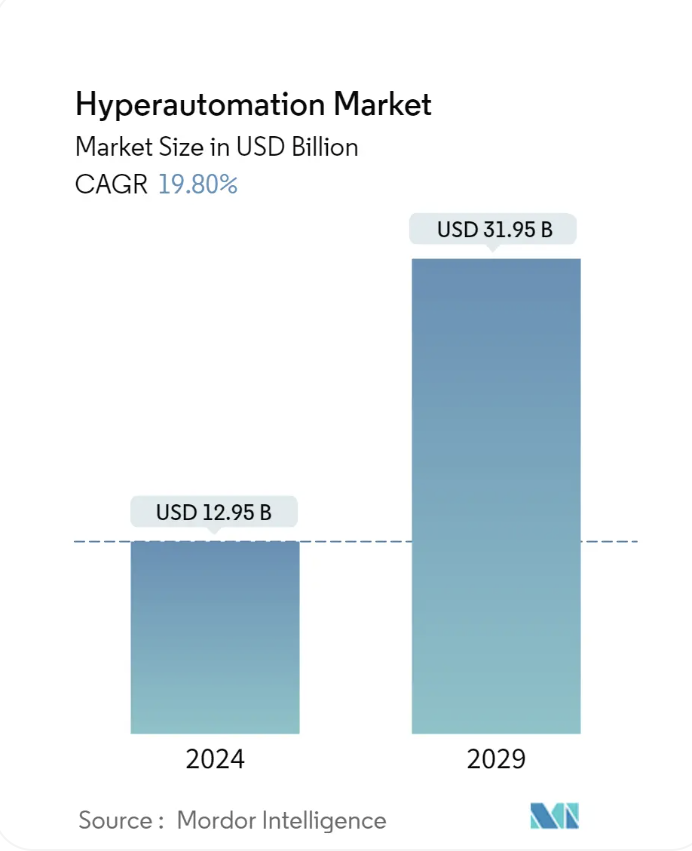
Source: Mordor Intelligence
The market for hyper-automation is booming. It is expected to reach $12.95 billion in 2024 and is projected to soar to $31.95 billion by 2029, growing at an impressive annual rate of 19.8%.
The surge in adoption reflects its power to boost lead conversion and improve efficiency across the marketing funnel.
4. Community-First Growth
One of the most promising growth marketing trends is having a solid community around your brand as a practical and powerful way to scale faster.
A loyal, engaged community drives repeat business and helps create brand advocates who spread the word, bringing in new customers organically.
Instead of focusing solely on transactional relationships, communities foster emotional connections that keep customers returning.
Take Peloton as an example. They didn’t just sell fitness equipment—they built a community by offering live classes, leaderboards, and social features that encourage users to interact with each other.
This turned their customers into passionate brand advocates, driving organic growth through word-of-mouth and social sharing.
Source: Instagram
To make this work for your business, start by creating dedicated spaces for your customers to connect. This could be a Facebook group, a branded community forum, or even regular virtual meetups.
Offer incentives for participation—such as exclusive content, challenges, or rewards for user-generated content (UGC).
The more value your community members feel they’re getting, the more they’ll engage and share your brand with others.
Practical Steps:
- Set up a community platform (Facebook Group, Discord, or dedicated forum).
- Encourage conversations by sharing prompts, challenges, or exclusive content.
- Incentivize UGC with shout-outs, rewards, or discounts for active participants.
- Create events (online or offline) to build real-time connections.
Key Metric to Track: Track user participation, the amount of UGC, and customer referral rates to measure the effectiveness of your community-building efforts and the impact on growth.
5. Content as a Growth Engine
Content marketing remains one of the most effective growth marketing trends to drive scalable growth, but to unlock its full potential, it needs to be applied across the entire customer journey.
Rather than focusing solely on top-of-the-funnel awareness content, it’s crucial to develop a strategy that provides value at every stage—from discovery and consideration to purchase and retention.
A key way to achieve this is by creating different types of content that match your customers’ needs as they move through the funnel.
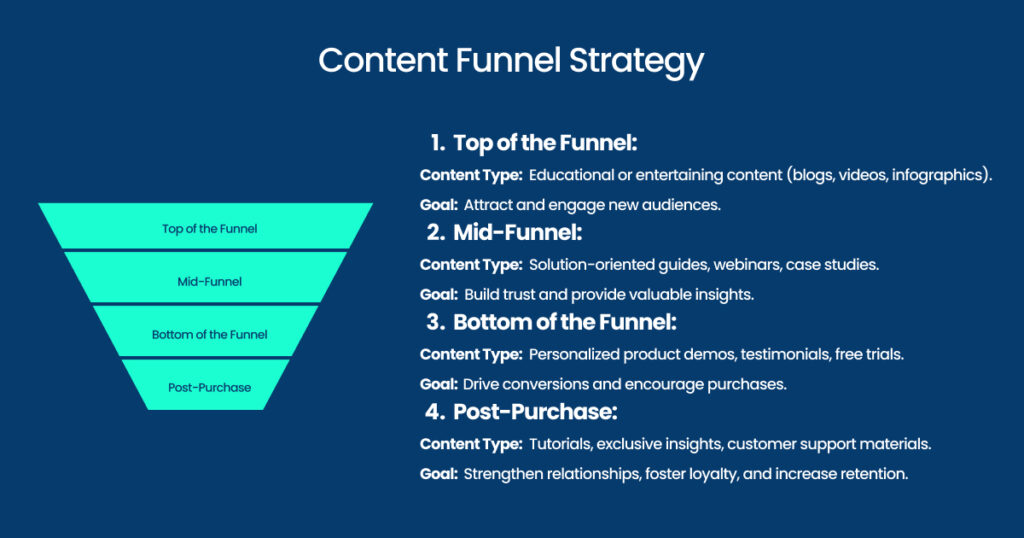
Key Metric to Track: Analyze the effectiveness of your content by tracking metrics such as traffic, lead generation, conversion rates, and customer engagement at different stages of the funnel.
6. Staying Ahead with Predictive SEO
Trends in growth marketing, such as SEO, are evolving, and it’s all about being proactive. Predictive SEO enables you to anticipate future search trends by analyzing consumer behaviors and emerging topics.
Instead of competing on popular keywords, you can focus on terms that are gaining momentum, giving you a head start.
With the rise of voice search, you’ll also need to optimize for longer, more conversational queries to capture more organic traffic.
Practical Steps:
- Use tools like Moz or Google Trends to track upcoming keyword trends.
- Adapt your content to focus on future-focused, long-tail keywords.
- Keep updating and refreshing content to align with changing search behaviors.
- Make sure your content answers common voice search queries.
Tip: Regularly track organic traffic growth and keyword rankings, especially for emerging trends and long-tail keywords. This will help you spot new opportunities, measure the impact of your predictive SEO, and adjust your strategy to capture high-intent traffic ahead of competitors.
7. Agile Experimentation with Micro Campaigns
In growth marketing, speed and flexibility are key. Instead of relying on large, slow-to-launch campaigns, agile experimentation with micro-campaigns allows you to test ideas quickly, gather insights, and scale the successful ones.
Micro campaigns are smaller, targeted marketing initiatives designed to test different strategies, messaging, or audiences with minimal risk and investment.
For example, instead of rolling out a full-scale product launch, run a short campaign targeting a specific audience segment with tailored messaging. Measure the response and adjust retargeting as needed.
This iterative approach helps you fine-tune your strategy and allocate resources more efficiently, ensuring you invest in campaigns that deliver real results.
To implement this strategy, test different ad formats, platforms, or messaging in small doses. Use A/B testing tools to see what resonates with your audience quickly. The goal is to experiment, analyze the data, and rapidly pivot to the most effective strategies.
8. Sustainable and Ethical Practices for Lasting Growth
Sustainable and ethical business practices are becoming more than just a bonus—they’re one of the expected trends in growth marketing. Consumers increasingly choose brands that align with their values besides generating demand and delivering great products.
Also read: Comparing Growth Marketing and Demand Generation: Which Is Right for Your Business?
Businesses that adopt eco-friendly and socially responsible practices can foster stronger customer loyalty, fueling long-term growth.
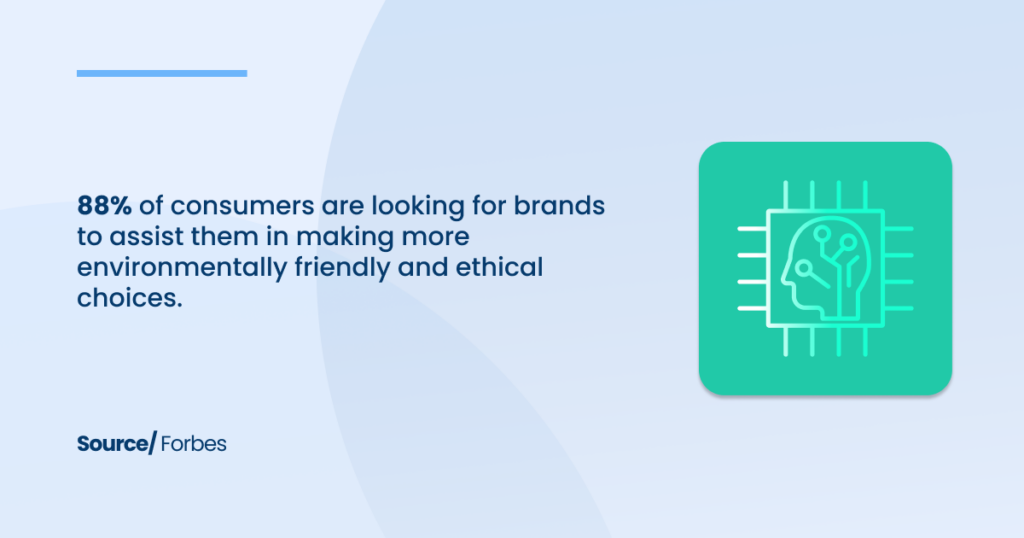
Source: Forbes
Look at brands like IKEA, which has committed to using renewable and recycled materials in their products. By leading with sustainability, they build trust and win over eco-conscious consumers.
To incorporate sustainability into your own business, start with small but impactful changes.
Whether it’s reducing waste or improving supply chain transparency, taking action on ethical practices will help differentiate your brand and drive growth.
9. Leveraging the Creator Economy for Organic Growth
The creator economy is transforming how brands grow. Last year, the influencer marketing market reached a value of $21.1 billion, 3 times more than in 2019.
In 2024, partnering with creators—especially micro and nano-influencers—has become one of the best ways to drive organic growth.
These influencers have small but highly engaged audiences that trust their opinions, making them powerful voices for your brand.
Unlike traditional ads, creator partnerships feel authentic and relatable, which is exactly what today’s consumers want. By working with creators who share your brand’s values, you can reach specific target audiences and build deeper connections.
The goal is to find influencers whose followers match your ideal customers and to focus on building genuine, long-term relationships.
For example, many beauty brands partner with micro-influencers to create product reviews or tutorials.
These influencers engage with small communities that trust their recommendations, leading to higher engagement and conversions.
10. Conversion Rate Optimization (CRO) as a Core Growth Strategy
Getting traffic to your website is important, but if visitors aren’t converting into customers, you’re missing out. That’s where Conversion Rate Optimization (CRO) comes in.
CRO is another customer-centric marketing trend that focuses on improving your website and customer experience to turn more visitors into buyers.
In 2024, it’s a key strategy for businesses wanting to scale quickly without spending more on ads.
Source: Market.us Scoop
CRO is all about testing and improving different parts of your website, such as headlines, calls to action, and checkout processes.
For example, simplifying your checkout process or speeding up page load times can increase conversions. Tools like heatmaps and A/B testing help you see what’s working and where users get stuck.
By regularly optimizing your website, you can increase conversions, lower your cost of acquisition, and get more value from the traffic you already have.
Take Your Business to the Next Level with [A] Growth Agency
Scaling your business in 2024 requires more than just traditional marketing tactics—it demands a strategic, data-driven marketing approach.
The growth marketing trends we’ve discussed are crucial for driving sustainable growth, from AI-powered personalization and predictive SEO to community-building and Conversion Rate Optimization.
Each of these strategies uniquely improves customer acquisition, increases engagement, and maximizes conversions.
At [A] Growth Agency, experienced growth marketers implement these growth marketing trends and other strategies to help businesses like yours achieve rapid and sustainable growth.
Our services include SEO optimization, content marketing, AI-driven personalization, conversion rate optimization, and data analytics—all designed to scale your business faster and more efficiently.
Partner with our Growth Marketing Agency if you’re ready to take your growth marketing efforts to the next level.
Our team of experts will work with you to develop and execute a tailored strategy that aligns with your goals and delivers measurable results.
Get your Free Marketing Plan to see how you can scale faster and smarter in the future!
